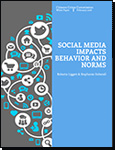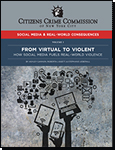| |
Resources: Social Media Behavior
FILTER RESOURCES BY TOPIC:
All Resources
· Crime Prevention
· Cybercrime
· DNA Databank
· Gang and Group Violence
· Illegal Gun Crime
· Juvenile Crime
· Social Media Behavior

|
|
E-Responder Evaluation: Cultivating Resilience and Sociopolitical Empowerment (2017)
E-Responder was developed by the Crime Commission in partnership with NYU and NYC Cure Violence to intervene with youth in new, virtual spaces of conflict. This third and final evaluation demonstrates that E-Responder had significant effects on two critical outcomes, both of which are predicted to facilitate positive long-term results for youth: (1) resilience, by building on youths' existing strengths, coping skills and empowering them to face adversity and grief; and (2) sociopolitical awareness, by providing youth with the vocabulary and opportunity to discuss topics such as inequality, oppression, privilege and race. The findings from the three research briefs demonstrate the effectiveness of E-Responder as an intervention engaging youth online, where they are highly involved and literate and moreover, that E-Responder is more than an intervention model; it is an early-prevention strategy.
» read the report
|

|
|
When Your Best Friend is Murdered: Experiences of Grief and Trauma with Crew-Involved Youth (2017)
Grief and trauma are critical drivers of violence and play significant roles in why young people become involved in crews, how conflicts become seriously violent, and underlying reasons for engaging in retaliatory violence. In order to cope with trauma and complicated grief, crew-membership and violence emerge as ways to receive social support, emotional release, safety, and purpose. In order to ensure we are meeting youths' needs holistically and preventing violence in the long-term we must include these life experiences when developing programs and policies.
» read the report
|

|
|
E-Responder Poster: Interruptions of Risky Online Behavior De-escalate Violent Conflict (2017)
E-Responder was presented at the Society for Community Research and Action (SCRA) 2017 Biennial Conference "Transformative Community Psychology" in Canada to discuss the innovative approach of conducting intervention through social media, research study, and results.
» read the poster
|

|
|
E-Responder Evaluation: Youth Leadership Program Results (2017)
E-Responder was developed by the Crime Commission in partnership with NYU and NYC Cure Violence to intervene with youth in new, virtual spaces of conflict. The Youth Leadership Program supports this mission by providing youth the opportunity to learn, build, and enhance life-skills that prevent violence and promote long-term success. In this second evaluation, results demonstrate the effectiveness of the Youth Leadership Program and the positive impacts the program had on youth.
» read the report
|

|
|
Social Media as an Opportunity for Service (2017)
The high visibility of harmful behavior, trauma, grief, and emotional distress on social media gives service providers the opportunity to know exactly who is at the highest risk for committing or being victimized by violence and in greatest need of service. We need to capitalize on this opportunity by giving anti-violence professionals a new method of responding to risky social media use. As modes of communication have changed to favor online spaces, so too must our interventions.
» read the report
|

|
|
E-Responder Evaluation: Interruption Toolkit Results (2017)
Increasingly, real-world violence follows fights started online, as social media amplifies and accelerates conflict. Results from the Citizens Crime Commission's E-Responder pilot study with NYU and NYC Cure Violence demonstrates the effectiveness of our innovative digital intervention in preventing virtual and real-world violence between youth involved in gun violence.
» read the report
|

|
|
Social Media Impacts Behavior & Norms (2016)
On social media, a recognized set of norms have not caught up with the speed in which social media has been adopted into our lives, leading to ambiguity concerning what behavior is appropriate. This paper explores the unique features of social media and their impact on behavior and social norm creation. Understanding the unique landscape of social media will assist others in understanding why problematic behavior—such as cyberbullying, threats, prejudice, violence, and harassment—continue to be pervasive in this space and what steps stakeholders can take to change norms and create a positive online environment for expression, engagement, and connection.
» read the report
|

|
|
Social Media & Real-World Consequences (2015)
Social media has become a part of everyday life. All types of real-world behavior are now showcased online—including criminal behavior, bullying, threats and the glorification of violence. Increasingly, youth associated with antisocial peer groups—such as neighborhood-based "crews" engaging in violent rivalries—use social media as a tool to create criminal opportunities and amplify conflicts. Unfortunately, in many cases, this type of social media usage can lead to real-life violence or other serious ramifications, such as arrest. The Crime Commission's series, "Social Media & Real-World Consequences", provides an overview of the ways youth are communicating on social media, the associated risks of these communications turning into real-world violence, and the range of legal, educational and professional consequences youth may face in the real-world.
» read Volume 1: From Virtual to Violent
» read Volume 2: Responding to Social Media Norms
|
|
|
NY Criminal Justice Agencies
NYC District Attorney's Offices
Federal Agencies
Emergency Preparedness
Crime Data and Resources
Other Crime Commissions
Criminal Justice Organizations
|






